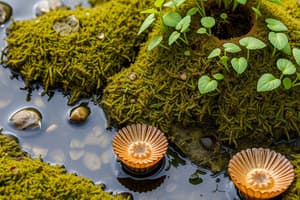Podcast
Questions and Answers
What type of organisms ingest bacteria and excrete NH4 & PO4?
What type of organisms ingest bacteria and excrete NH4 & PO4?
- Plants
- Detritivores
- Coral
- Protozoans (correct)
Which organisms release more nutrients during their lifetime compared to post-mortem decomposition?
Which organisms release more nutrients during their lifetime compared to post-mortem decomposition?
- Detritivores
- Plants
- Protozoa (correct)
- Coral
Where do symbiotic zooxanthellae live and interact with coral tissues?
Where do symbiotic zooxanthellae live and interact with coral tissues?
- Within plant roots
- Within coral tissues (correct)
- Inside plant stems
- In the air around corals
Which pathway involves the direct action of solar energy in nutrient cycling?
Which pathway involves the direct action of solar energy in nutrient cycling?
Which organisms are important in nutrient-poor environments and engage in direct recycling from plant to plant?
Which organisms are important in nutrient-poor environments and engage in direct recycling from plant to plant?
What is a key process involving the use of fuel energy mentioned in the text?
What is a key process involving the use of fuel energy mentioned in the text?
What is the primary source of energy for most ecosystems?
What is the primary source of energy for most ecosystems?
Which of the following is an example of a chemoautotroph?
Which of the following is an example of a chemoautotroph?
What is the main difference between a grazing food chain and a detritus food chain?
What is the main difference between a grazing food chain and a detritus food chain?
Which trophic level in a food web would contain the organisms that produce their own food?
Which trophic level in a food web would contain the organisms that produce their own food?
What is the role of decomposers in an ecosystem?
What is the role of decomposers in an ecosystem?
How does the second law of thermodynamics affect the flow of energy in an ecosystem?
How does the second law of thermodynamics affect the flow of energy in an ecosystem?
What is the main role of mycorrhizal fungi in tropical nutrient cycling?
What is the main role of mycorrhizal fungi in tropical nutrient cycling?
What is the primary function of the "drip tips" on leaves in tropical ecosystems?
What is the primary function of the "drip tips" on leaves in tropical ecosystems?
How do thick barks in tropical trees contribute to more direct nutrient cycling?
How do thick barks in tropical trees contribute to more direct nutrient cycling?
What is the primary role of algae and lichens covering leaf surfaces in tropical nutrient cycling?
What is the primary role of algae and lichens covering leaf surfaces in tropical nutrient cycling?
Flashcards are hidden until you start studying
Study Notes
Nutrient Cycling
- Protozoans ingest bacteria and excrete NH4 and PO4
- Plants take up nutrients through their roots
- Detritus pathway or detritus cycle involves the decomposition of organic matter
- Microbial loop is an important mechanism in nutrient cycling
Animal Excretions
- Small animals excrete dissolved inorganic and organic compounds, including phosphorus, nitrogen, and carbon dioxide
- Excretions are directly usable by plants without further breakdown by bacteria
Microbial Symbionts
- Symbiotic organisms play a major role in direct recycling of nutrients from plant to plant
- Important in nutrient-poor or oligotrophic environments
- Coral-dinoflagellate symbiosis is an example of direct recycling of nutrients
- Symbionts (zooxanthellae) live within coral tissues and take up nutrients, which are then used in photosynthesis
Physical Means of Nutrient Cycling
- Solar energy drives the hydrologic cycle
- Fuel energy is used in industrial processes such as desalination, fertilizer production, and metal recycling
Biogeochemical Cycles
- Cycling occurs within systems, such as the PCB (polychlorinated biphenyl) cycle
- Nutrients can be stored in soil and wood in temperate ecosystems
- Freezing temperatures help retain nutrients and control pests and parasites
- Community control and nutrient cycling are influenced by physical factors
Tropical Ecosystems
- Primary nutrient storage is in tissues (wood) in tropical ecosystems
- High year-round temperatures and long periods of rainfall decrease the ability to retain nutrients
- Community control and nutrient cycling are influenced by biological factors
Nutrient Cycling Mechanisms
- Root mats with fine-feeder roots recover nutrients from leaf fall and rainfall
- Mycorrhizal fungi associated with root systems increase nutrient recovery
- Thick and waxy evergreen leaves retard water and nutrient loss
- Leaves with "drip tips" drain off rainwater and prevent leaching of leaf nutrients
- Algae and lichens covering leaf surfaces scavenge nutrients from rainfall
- Nitrogen fixation occurs in lichens
Recycling Pathways
- Microbial decomposition is a major recycling pathway
- Bacteria, fungi, and other microorganisms in soil and natural waters are involved in decomposition
- Ecosystems are open systems with respect to energy and closed systems with respect to nutrients
Energy Flow
- Energy is not created or destroyed, but transferred from one form to another
- Entropy increases as energy is transferred from one form to another
- Heat is a byproduct of all living organisms
- The Laws of Thermodynamics guide energy flow
- Sunlight provides energy for ecosystems
- Food chains and food webs are forms of energy transfer
- Detritus food chains and grazing food chains are types of energy transfer
Food Chain and Food Webs
- Autotrophs are the first trophic level and can make their own food
- Photoautotrophs use sunlight, while chemoautotrophs use chemicals
- Consumers are herbivores, omnivores, and carnivores
- Decomposers/detritivores are scavengers and saprotrophs that break down organic matter
Studying That Suits You
Use AI to generate personalized quizzes and flashcards to suit your learning preferences.




